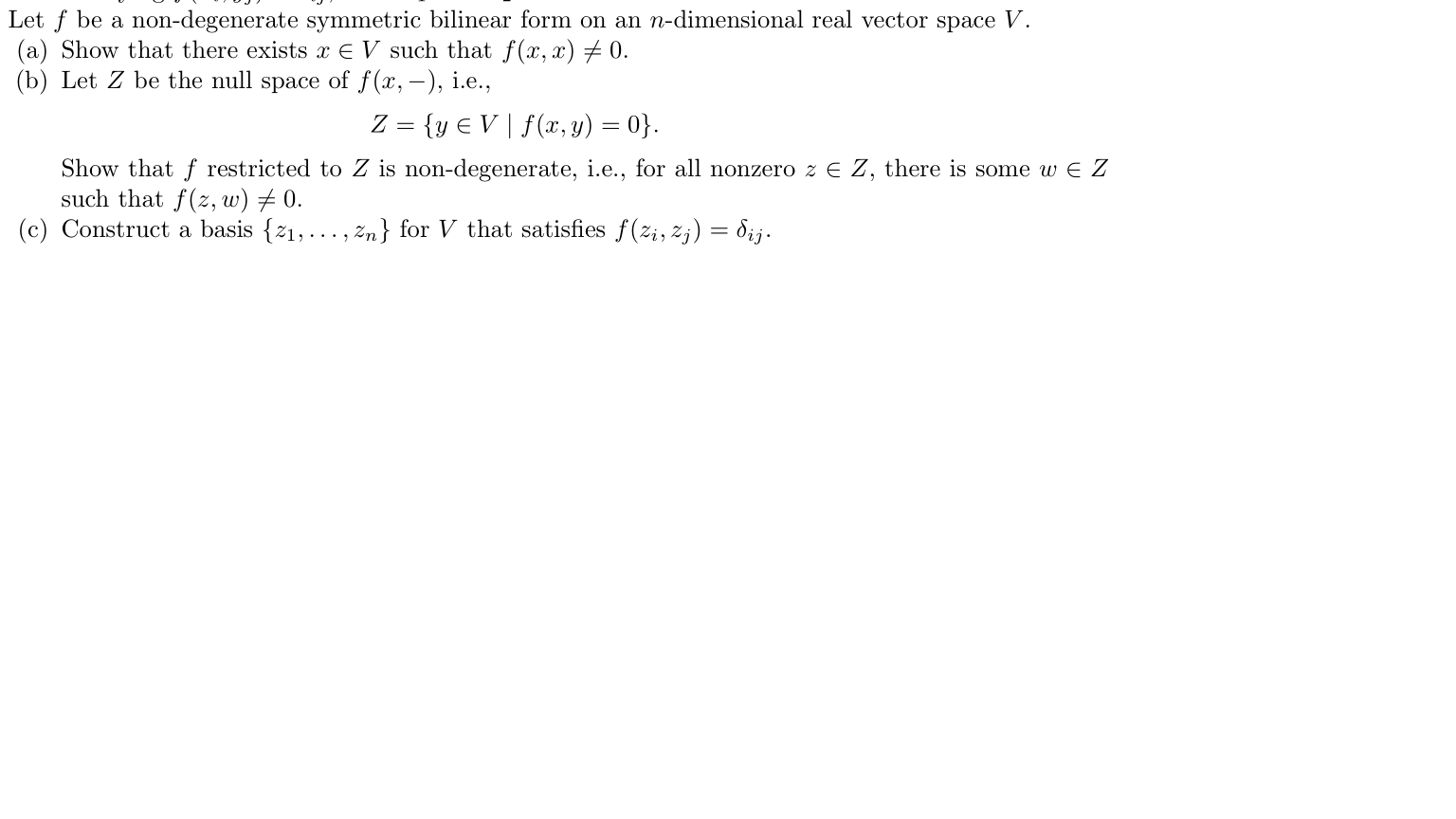Any Bilinear Invariant Form Is Nondegenerate
Any Bilinear Invariant Form Is Nondegenerate - If ¯k = k, then a bilinear form is unique up to multiplication We call a bilinear form b nondegenerate if the discriminant of b is nonzero. For multilinear forms v^k to r, asking that the induced map v. The map f is nondegenerate if and only if this subspace is trivial. In other words, there doesn't exist a vector. Now let us discuss bilinear. $f$ is non degenerate, then the matrix of $f$ is invertible, which means it's square and this implies that $v$ and $w$ have the same dimension.
To be able to apply the properties of the discriminant and nondegeneracy, we must first understand orthogonality. V → v by this is often denoted as where the dot ( ⋅ ) indicates the slot into which the argument for the resulting linear functional is to be placed (see currying). For multilinear forms v^k to r, asking that the induced map v. Now let us discuss bilinear.
As a corollary, we prove that every complex lie algebra carrying a nondegenerate invariant symmetric bilinear form is always a special type of manin pair in the sense of drinfel’d but not. It is clear that if g = gl n(k) and v = kn then the form bv is nondegenerate, as bv (eij; Now let us discuss bilinear. To be able to apply the properties of the discriminant and nondegeneracy, we must first understand orthogonality. V → v by this is often denoted as where the dot ( ⋅ ) indicates the slot into which the argument for the resulting linear functional is to be placed (see currying). Show that a symmetric bilinear form is nondegenerate if and only if its matrix in a basis is invertible.
Is my assumption that the matrix. If f vanishes identically on all vectors it is said to be totally degenerate. Now let us discuss bilinear. Given any bilinear form f on v the set of vectors forms a totally degenerate subspace of v. As a corollary, we prove that every complex lie algebra carrying a nondegenerate invariant symmetric bilinear form is always a special type of manin pair in the sense of drinfel’d but not.
To be able to apply the properties of the discriminant and nondegeneracy, we must first understand orthogonality. In other words, there doesn't exist a vector. We call a bilinear form b nondegenerate if the discriminant of b is nonzero. Every bilinear form b on v defines a pair of linear maps from v to its dual space v.
$F$ Is Non Degenerate, Then The Matrix Of $F$ Is Invertible, Which Means It's Square And This Implies That $V$ And $W$ Have The Same Dimension.
Show that a symmetric bilinear form is nondegenerate if and only if its matrix in a basis is invertible. In other words, there doesn't exist a vector. How do i show that the bilinear form on functions in $[0,1]$ is degenerate, but becomes nondegenerate when restricted to continuous maps? Also if n is not divisible by the characteristic of k then sln(k) is semisimple,.
Now Let Us Discuss Bilinear.
As a corollary, we prove that every complex lie algebra carrying a nondegenerate invariant symmetric bilinear form is always a special type of manin pair in the sense of drinfel’d but not. The map f is nondegenerate if and only if this subspace is trivial. Geometrically, an isotropic line of the quadratic form corresponds to a point of the associated quadric hypersurface A bilinear form ψ :
If F Vanishes Identically On All Vectors It Is Said To Be Totally Degenerate.
Given any bilinear form f on v the set of vectors forms a totally degenerate subspace of v. V → v by this is often denoted as where the dot ( ⋅ ) indicates the slot into which the argument for the resulting linear functional is to be placed (see currying). For real lie algebras, is any invariant bilinear form a scalar multiple of the killing form? If ¯k = k, then a bilinear form is unique up to multiplication
We Call A Bilinear Form B Nondegenerate If The Discriminant Of B Is Nonzero.
Every bilinear form b on v defines a pair of linear maps from v to its dual space v. It is clear that if g = gl n(k) and v = kn then the form bv is nondegenerate, as bv (eij; For multilinear forms v^k to r, asking that the induced map v. To be able to apply the properties of the discriminant and nondegeneracy, we must first understand orthogonality.
If ¯k = k, then a bilinear form is unique up to multiplication Now let us discuss bilinear. Given any bilinear form f on v the set of vectors forms a totally degenerate subspace of v. As a corollary, we prove that every complex lie algebra carrying a nondegenerate invariant symmetric bilinear form is always a special type of manin pair in the sense of drinfel’d but not. The map f is nondegenerate if and only if this subspace is trivial.






![Solved 3] Let V be an dimensional vector space over F, and](https://i2.wp.com/media.cheggcdn.com/media/70b/70b2c1b9-c546-4f34-b86e-14026d34abcc/phpK8xZQM.png)
